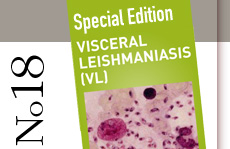 |
|
|
|
|

a Changing Landscape for VL
The stark frustrations of a decade ago - when there were only a few limited treatments for patients suffering from visceral leishmaniasis (VL) - are no longer an issue. New drugs and diagnostics are beginning to transform treatment of this potentially fatal disease. However, there is still much to be done before these developments become the standard treatments accessible to all patients. A number of the presentations made during the recent 4th World Congress on Leishmaniasis, held in Lucknow, India, (3-7 February, 2009) highlighted some promising developments:

There are some new treatments available to treat VL. Until the year 2000, we were still reliant on 60-yearold antimonials for treatment. Since then however, several new drugs for VL have become increasingly available – thanks, in part, to the work of the WHO in establishing preferential pricing for countries in the developing world. Of these, AmBisome® (a therapeutic switch of an effective antifungal) holds particular interest, as it can provide a cure with a single dose, and has been well integrated into MSF’s programme in the Bihar state, as presented by Dr. Nines Lima; miltefosine (an oral treatment) because it is part of the VL elimination programme for the region; and paromomycin (a low-cost injection) as it is registered in India and is on the essential medicines list in Bangladesh.
Because there are still few current therapies available, each having their own limitations, optimal use must be made of current drugs. In considering best options for treatment, it is useful to learn how treatment regimens have evolved for other major infectious diseases like HIV/AIDS, tuberculosis, and malaria. In all of those cases, combination chemotherapy is preferred to simple monotherapy; Dr Johan Van Griensven and Filip Meheus’ costeffectiveness analysis showed the clear advantages of combination therapies over existing monotherapies.

As evidenced by the work of the Institute for One World Health (iOWH), the Drugs for Neglected Diseases initiative (DNDi), and the Consortium for Parasitic Drug Development (CPDD), partnerships are actively contributing to the development of new drugs, or better use of existing ones. At the meeting, iOWH presented some promising field research data on paromomycin in India. DNDi made presentations on the ongoing clinical research in Africa and India as well as the promising early-stage efforts to discover and develop new drugs for VL, such as the new high-content screening programme being developed at the Institute Pasteur Korea, and the lead optimisation programme from the promising 2-quinoline series which is the result of DNDi ’s leadership of a network of partners, including Advinus Therapeutics, Central Drug Research Institute (CDRI), and the Institut de Recherche pour le Développement (IRD).

Improved case management on the horizon with better diagnostics being developed to ensure better treatments. Results presented during the Infectious Disease Research Institute’s symposium on diagnostics showed a variety of interesting avenues being explored to develop direct, noninvasive tests which could be adapted to the field. These non-invasive tests are being developed for definitive diagnosis as well as assessment of therapy. Such tests have to be evaluated and integrated into clinical research on improved drugs.
At WorldLeish4, we benefitted from numerous presentations which showed the growing output from research efforts on visceral and cutaneous leishmaniases, and the essential dialogue between the research communities (academics, drug developers, field researchers, control programmes) in a way that has never existed before. The presentations by the Leishmaniasis East Africa Platform (LEAP) on both clinical research and parasite identification from different sites in Africa showed the breadth of research being shared among the groups - from Africa to the Indian subcontinent to Latin America.
The promise of the research, development, and the greater spirit of cooperation within the R&D community provides the platform for more effective control of these complex and neglected diseases. Effective tactics, in coordination with the WHO/Neglected Tropical Diseases department, and bolder commitments from the various stakeholders will help achieve the Millennium Development Goals. The greater attention being paid to VL must not only come from the research community and philanthropic donors like the Bill & Melinda Gates Foundation; governments worldwide must take responsibility for creating, funding, and implementing a needsbased R&D agenda.
VL is closely associated with poverty in a vicious cycle – it is a disease of the poor, and it drains the scarce resources of afflicted populations. The journey has begun – let us continue to take steps together so that the needs of the least privileged, suffering from the most neglected diseases, are appropriately met.